Growing Blog
The Fruiting Block: Growing Gourmet Mushroom on Sawdust
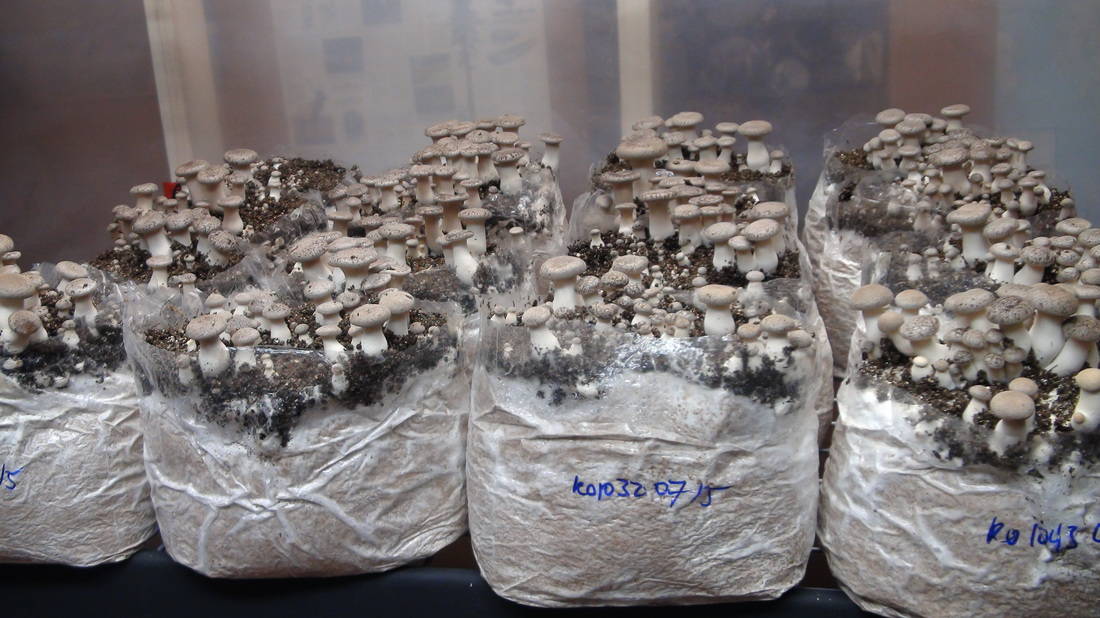
Contents
- The Fruiting Block Recipe:
- How To Grow Mushrooms on Supplemented Sawdust Fruiting Blocks
- Step 1: Measure out the components
- Step 2: Add Water to Sawdust Pellets
- Step 3: Add Wheat Bran
- Step 4: Add Mixture to Grow Bags
- Step 5: Fold the Bags Down
- Step 6: Pressure Sterilize
- Step 7: Cool Down and Inoculation
- Step 8: Allow to colonize
- Step 9: Fruit!
- Step 10: Harvest
Many types of mushrooms , specifically oysters, will do great and fruit heavily on straw logs as was explained in this post.
However, most gourmet mushrooms will actually do way better if grown on hardwood sawdust supplemented with some sort of nitrogen rich supplement.
Growing gourmet mushrooms on sawdust blocks will require a little bit more initial work than straw logs, and more equipment- mainly because sawdust blocks need to be pressure sterilized- unlike straw logs which need only to be pasteurized.
However, the process is quick, less mess, has lower chances of contamination, and provides a perfect medium for the mushrooms to grow large healthy fruits.
The basic recipe we use to grow all our gourmet mushrooms uses hardwood sawdust pellets, wheat bran, and water. Hardwood pellets are used because they are readily available at local retail stores or online, and store easily.
Make sure to get hardwood pellets and not softwood pellets. Mushrooms do not grow well at all on softwood.
The pellets are small and only expand when soaked in water. Wheat bran is used as the nitrogen rich supplement. It can be found in small quantities at your local grocer, but can be quite expensive.
A better option is to buy some from a feed or farm store. Oat bran can also be used, but we have found wheat bran to be the most effective. As for water, the trick is to add just the right amount to get a proper moisture content.
You don’t want your block to be too wet or too dry. The following recipe works great for use, but you may have to adjust it slightly to suit the specific moisture content of you pellets.
The Fruiting Block Recipe:
For every 5 lb fruiting block:
- 5 cups of hardwood pellets
- 1.4 liters water
- 1-1/4 cups wheat bran
How To Grow Mushrooms on Supplemented Sawdust Fruiting Blocks
Step 1: Measure out the components
The above recipe will make a block weighing approximately 4 lb 4 oz. Your final bock should end up weighing 5 lbs after you add 12 oz of grain spawn. Its best multiple blocks at a time, as many as can fit inside your pressure sterilizer.
This presto pressure canner is relatively cheap and can hold 4 large blocks, made with 20 cups pellets, 22.5 cups water and 5 cups wheat bran
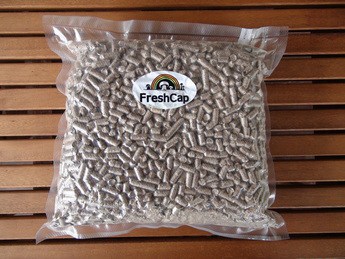
Step 2: Add Water to Sawdust Pellets
Place your hardwood sawdust pellets in a large tote or suitable container for mixing. Add the correct amount of water and mix until the pellets have broken up into a loose sawdust texture. Adding warm water makes the sawdust break up much quicker but is not necessary, as cold water works just fine. It may take a while to mix up all the pellets, but you want to be sure it has all broken down because the mushrooms will have a much harder time breaking down the hardened pellets.
Step 3: Add Wheat Bran
Once the sawdust is mixed up and all the pellets are broken down, add the correct amount of bran. You can increase the amount of bran to add more nutrition into the block, but more bran will increase the chance of contamination and adding more will eventually lead to diminishing returns. Make sure to mix the bran thoroughly and evenly throughout the sawdust.
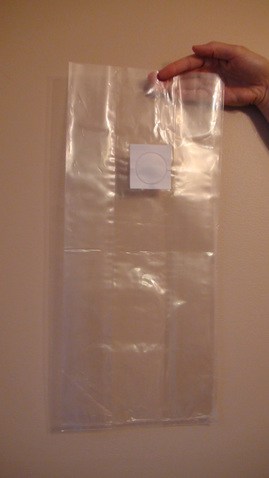
Step 4: Add Mixture to Grow Bags
Weigh out the proper amount of sawdust/bran mixture and add it to a grow bag. I add 4 lbs 4 oz to each grow bag, which makes a 5 lb block once the spawn is added.
The bags are specially made for growing mushrooms. They are made of poly propelyne which can withstand the sterilization process. The Filter patch allows the mushrooms to breath while they are colonizing the substrate.
Step 5: Fold the Bags Down
The tops of the grow bags are gusseted and should be folded down in a specific way, with a filter fitted in between the gussets. This prevents contamination during cooldown after sterilization. When the bags cool down, air will be drawn into the bags.
If there is no filter between the gussets, dirty air can sneak through and ruin your project. By slipping a filter in between the gussets you can alleviate this problem.
Once the filter is slipped in, fold the top of the bags over a couple times. For the filter, you can use a cut piece of tyvek or a square cut from a painters suit.
Step 6: Pressure Sterilize
Load your pressure sterilizer with the bags stacked on top of each other.
Make sure to use jar lids or something that will keep your grow bags from making direct contact with the bottom of the sterilizer, as this could cause the bags to burn. Fill with the water to just below the top of the bottom bag.
You will need more water than when making grain jars because you will be sterilizing for much longer. Also, be sure to add a plate or something heavy to the top of the bags. If you don’t do this crucial step, you run the risk of the bag clogging the weight and the pressure relief valve on the pressure cooker.
This could cause pressure inside the cooker to reach dangerous levels. Pressure sterilize your bags for 2.5 hours.
This seems like a long time, but it is necessary for the heat to fully penetrate the the inside of the block and fully kill all contamination.
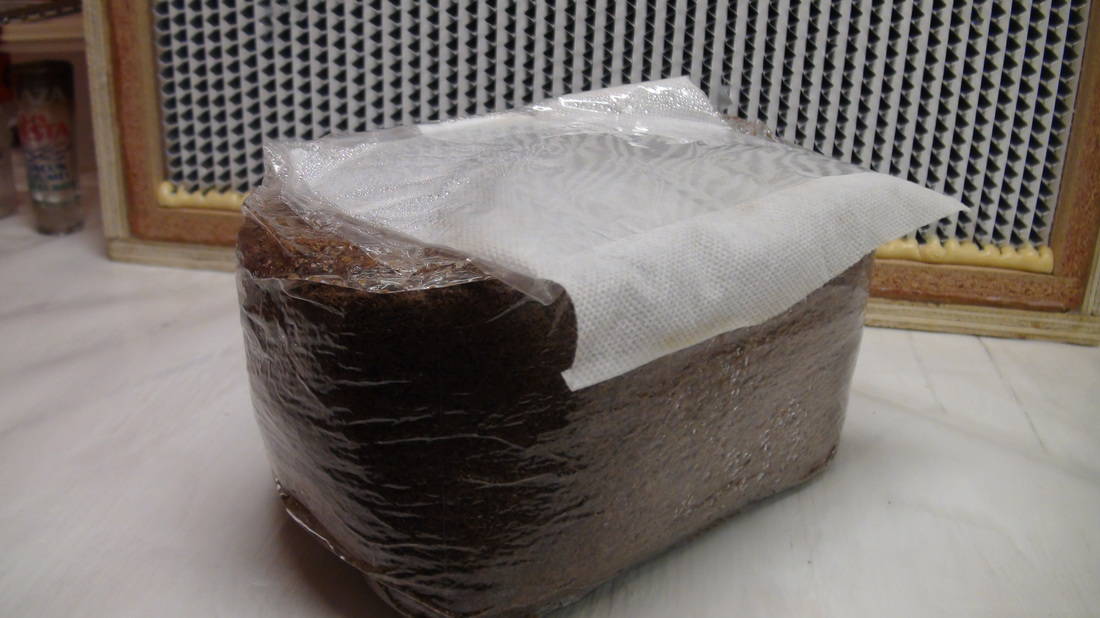
A fruiting block post-sterilization ready to be inoculated with grain spawn. Notice how the filter patch is slipped in between the gussets and the top is folded over twice.
Step 7: Cool Down and Inoculation
Allow your fruiting blocks to cool down for at least 8 hours. I like to pressure sterilize at night and allow the pressure cooker to fully cool down over night. Anything over 38 deg C can potentially kill your mycelium.
Fruiting blocks are best inoculated in front of a laminar flow hood. You can do it in a glove box or similar, but you will increase your chances of contamination. Once you have added grain spawn to your sawdust block, tie off the top of the bag with a piece of wire or zip tie and set on a shelf.
Shake the bag to evenly distribute the individual grains throughout the bag. This will speed colonization of the block.
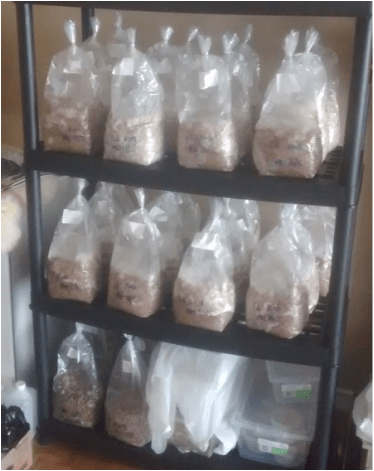
Grow bags colonizing on a shelf.
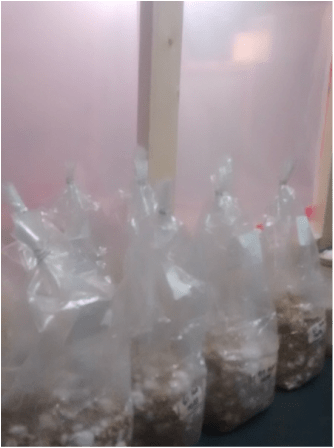
Grow bags after inoculation. Note the mixing of the grain spawn.
Step 8: Allow to colonize
Depending on the amount of spawn and type of mushroom you are trying to grow, it might take anywhere from 10-21 days for the mycelium to take over the block. There is no benefit to shaking the bag during colonization, just allow the grain spawn to take over the block naturally. Periodically look over the bag to check for any signs of contamination. Usually, it is not worth opening contaminated bags in your grow room, so it is better to just throw them out if the bags look contaminated.
Step 9: Fruit!
Once the bags have fully colonized consolidated, they are ready to fruit. Different mushrooms have different requirements from this stage, but for most gourmet mushrooms, just cut off the top of the bag and place inside your growing environment. From here, the block should start to pin from the top of the block, and eventually form mushrooms. Closely monitor humidity and temperature to see what your block needs.
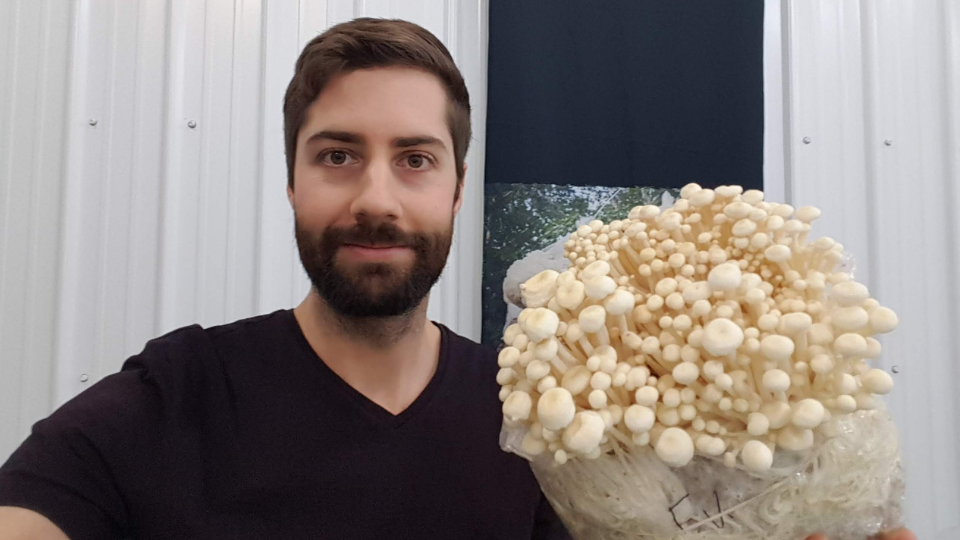
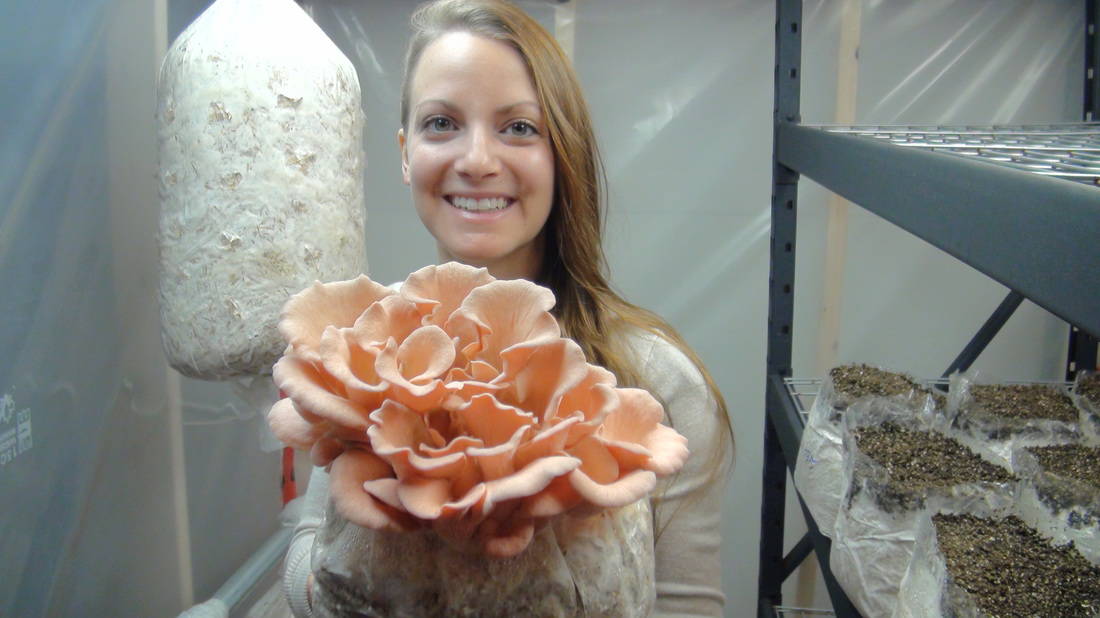
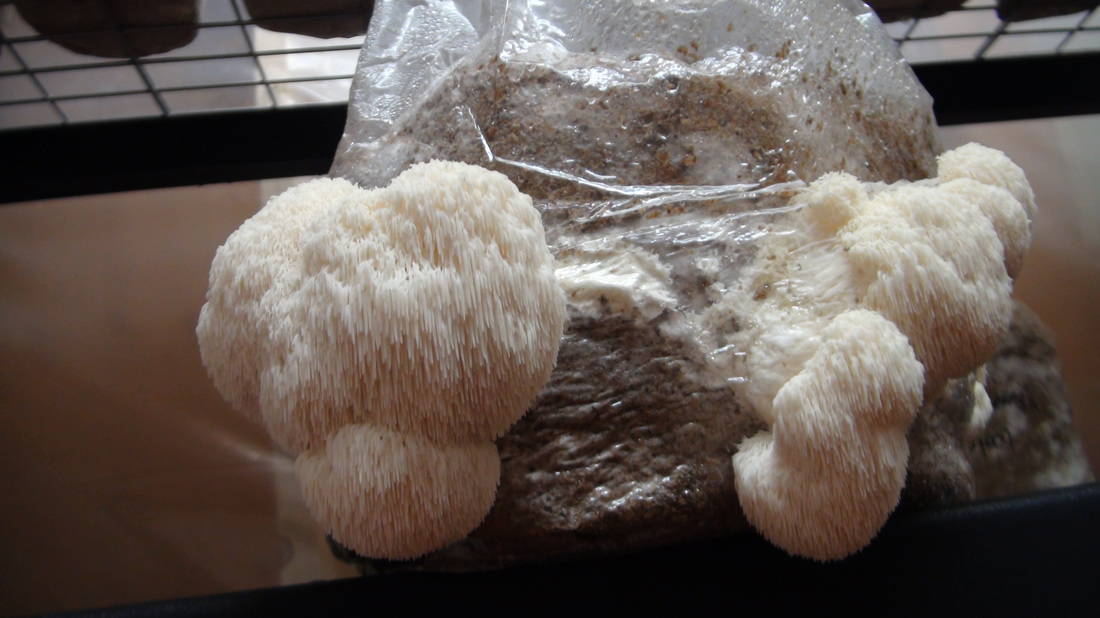
Step 10: Harvest
Once you are satisfied with the size of your fruits, they are ready to be harvested and enjoyed. The best strategy is to cut the mushrooms off at the stem trying not to damage the underlying block, since it can be used to get 3-4 flushes if properly taken care of. Once harvested, simply place your block back into a fruiting environment and wait for a subsequent flush. Watch closely for contamination as your blocks gets older. Often new mycelial growth will take over the harvested portions of the block before a second flush arrives.
Thanks for reading and good luck with your grows!
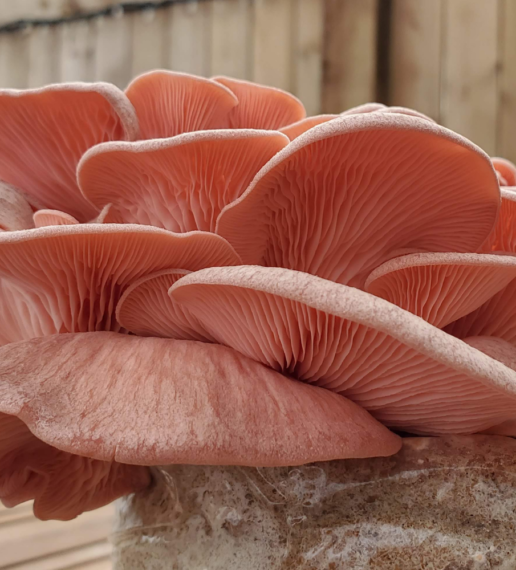
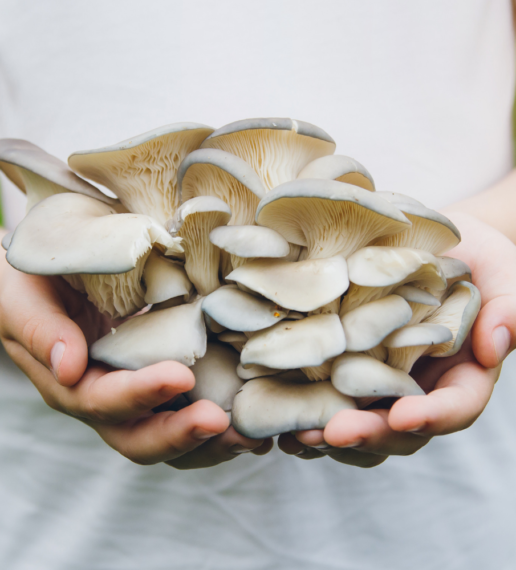
Would a liquid inoculation be easier via hypodermic needle, rather than opening the bag up? Just like getting a shot at the doctors office. Clean the area with alcohol, flame needle, administer LI and then tape the tiny hole up. Then you could have successful grows without a flow hood, at least for a hobbyist.
Absolutely, as long has you have a clean culture, this should work just fine. Let me know how it works for you! I know some people make “self healing injection ports for this very purpose. Use a high temp silicone sealant to make them on mason jar lids. It might also work just directly through the bag as you described, but I have never tried.
I’ve done this, a couple things to note:
The silicone doesn’t really want to stick to the bag, so you’ll want to put micropore tape or something over it to keep it from coming loose.
Also, hold the opposite wall of the bag away from the port when injecting into the bag and angle the needle down towards the substrate, if you don’t, it’s surprisingly easy to accidentaly poke through the other side.
The method works very well so long as you keep those things in mind.
How bad of an idea would it be to put the premixed sawdust, bran and water in a pressure cooker without bags? I’m actually going the bucket and mason jar route to cut down on plastic usage. The only thing I worry about is the sawdust keeps expanding in the pot and could possibly clog holes, creating a potential bomb in my kitchen. I was just wondering if you may of done this or know someone who has successfully. Thanks
Hi John! I am not sure about this… it may sterilize the substrate just fine, but as soon as you open the pressure cooker it will again be contaminated. The bags provide a way for the substrate to remain sterile the whole way through. The reason we can pasteurize straw and then inoculate it in the open air is because straw isn’t nearly as nutritious and won’t contaminate as fast.
exploding pressure cooker, happened to me, only the lid took off, the gasked did not seal/seat, properly almost killed me in my kitchen when autoclaving substrate,
Yah don’t do that unless you want your pc to blow up. Lose material is never good.
I’m very much into less plastic use. My idea is to turn the canning jar lids upside down so they do not seal. Use half gallon jars full of substrate. I’ve got 2 23 quart canners so should be able to get 8 jars a run… Thoughts?
Look into growing your mushrooms on straw in plastic buckets. Less plastic waste. I used to farm them commercially that way.
In what conditions did you fruit your buckets? I have made a few bucketsof Italian and blue oysters but came out with very leggy small fruits each time.
use the jars in your press cooker
Tony, What type of Hardwood do you suggest for Oysters?
Hey Bryan!
Pretty much any kind will work! I use a mix of all different types of hardwood, usually in pellet form. Straw works really well for oysters as well!
If you wanna do some outdoor Oyster Totems , Cottonwood works great !
You can seal the Cuts between the Rounds, and between the Cardboard and the first Round with wet Clay.
Also the Top of the Top Round seal with Clay .I just built a few more since my first Totem was an amazing success.
Very inspired Steve
This is a great idea! Perhaps I will try it this summer.
Man that sounds cool but I really need a visual cause I cant grasp it. Here in Texas where I live we lack a lot of Oaks but there is a ton of big cottonwood in river bottoms and I think this would be awesome…any links to a pic of how this is done? thanks
Oak
good day to all of you this is a excellent info thanks
all best from germany
steve
Hi Tony,
why must sawdust be pasteurized by pressure and not temperature?
Also, what process would you recommend when pasteurizing coffe grounds?
Cheers,
Jack
∗Edit…
the coffee grounds have not been pasteurized in a coffee machine,
but rather have been used to make cold brew,
jack
Hi Jack! It is actually the higher temperature that is required to sterilize, but the pressure is what is needed to get steam to that temperature. At 15 PSI, the steam temperature inside the cooker is 121 deg C, enough to kill off all contaminates. If you tried to do it at atmospheric pressure, the temperature would not be able to rise above 100 deg C. For coffee grounds, I would suggest full sterilization in a pressure cooker, but many people have had luck with just pasteurizing in a hot water bath for 90 minutes (65-82 Deg C). Hope that helps!
I live very close to a wood shop, they have truck loads of hardwood sawdust, could I us it instead of the wood pellets?
Absolutely, in fact it may be preferable! Just make sure that there is not a lot of glue or anything in the sawdust… if you can get pure hardwood sawdust (beech, elm, maple, oak ect.) then you have hit the jackpot! Hardwood Fuel Pellets work well for people who do not have easy access to pure sawdust.
Hi Tony, are there particular types of elm, maple or oak that work/won’t work as hardwood sawdust? A local sawmill near me has HARD MAPLE, SOFT MAPLE, RED ELM, RED OAK, WHITE OAK. Will they all work? Thanks for all the info!!
I can’t say for sure, but definitely think it would work just great! Worth giving it a try 🙂
I wanted to ask the same question but I’m worried that the sawdust from the workshop comes from wood treated with heavy metals or nasty chemicals (even just bleached). Do you know if that could end up in the mushroom and ultimately in my blood stream?
Hello
I have two questions for you please:
1. I have a small steam distillation plant for producing essential oils such as Cinnamon leaf oil. This is running at atmospheric pressure. I can direct and inject the steam deep into the middle of the saw dust bag using 2 mm bore copper tube … with a thermal lance arrangement. In addition I can expose the PP bags filled with saw dust to Ultra violet light too for sterilisation. Your comments would be highly appreciated on this sterilizer procedure.
2. What sort of moisture level or wetness do we have to maintain in the saw dust media once the sterilizer procedure is over?
Thank you
Mal
Hey Mal!
1. I have never tried this, but I don’t see why it couldn’t work, other than the fact that the temperature of the steam may be too low to kill all the contamination. It may be worth a try though. You may just have to steam them for a much longer time, which likely won’t be all that efficient.
2. The sawdust substrate is contained in the bag, and the moisture level doesn’t change much.
Hope that helps!
Tony
Hi Tony,
I’ve got a portobello liquid culture, can I use that to inoculate sawdust/rice bran/gypsum cake?
Or I need a specific formula for portobellos spawn?
English isn’t my first language,
Thanks
To be honest, I am not that well versed in growing Agaricus species (Portabello included) – but I would think they require some sort of composted substrate, such as manure in order to grow properly. Portabello is not a wood loving species like the other gourmet varieties.
You mention in step 4 “Weigh out the proper amount of sawdust/bran mixture and add it to a grow bag. I add 4 lbs 4 oz to each grow bag, which makes a 5 lb block once the spawn is added.”
But reading further you don’t mention when to add the grain spawn. Also in other recipes on your site the grain spawn is not mentioned. Is it necessary?
I am trying to find an easy recipe to start my first batch in jars and inoculate via syringe.
Hey Sorcha! Thanks for reaching out! The spawn is added to the block after the block is sterilized. Grain spawn is used as a way to “inoculate” the block with the mushroom culture. Once the spawn is added and mixed, it will start to grow through the block, eventually fully colonizing and fruiting. If you are inoculating from a syringe, you essentially have a “liquid culture” which can serve the same purpose as grain spawn. It can be added directly to the block, without the need for grain spawn, although the results might not be that great. A better option is to inoculate sterilized grain and make your own grain spawn, which can be added to the block as described above. Hope that makes sense!
Hi Tony, Love your site, Could you suggest more information on how to fold the bags in step 5. I think everything else was expertly explained.
Sure thing! Basically, the idea is to fold the top of the bags over twice with the filter slipped in between the gussets. BUT- I have also been experimenting with simply folding the top of the bag over once, without the filter- and so far it has been working just fine. As long as you use the bag relatively quickly after cool down, you should be OK with a simple fold over. Hope that helps!
Hi Tony, I don’t understand the instructions in Step 5, English isn’t my first language, maybe you can explain it for me: Im confused with the instruction of “a filter fitted in between the gussets” the image doesn’t make it clear, when you say the filter you dont mean the filter patch of the bags right? its something additional i think, but I’m not sure how to do it or even what are the “Gussets” lol
I was a bit confused about that too then found the video where he shows it. Believe it is this one: https://www.youtube.com/watch?v=k345CuMoP5E
Looks like a piece of some kind of filter slipped in, which acts as an extra barrier as the bags cool, since they will be trying to draw air in. He also said above he has been having success simply folding them twice with no filter.
What kind of wood (sawdust), is good for Mushroom cultivation ?
Hey Reza! Generally any type of hardwood… beech, elm, oak, ash, ect. Usually you can find a mixture of hardwoods.
Hi Tony,
Thanks for the wonderful information. I am trying to start a mushroom farm in central himalayas in 2018, so am lapping up what all you put down on your site.
Is there any alternative to disposable plastic bags? They have already created a lot of pollution in India and I want to avoid them if possible. For oysters, I did read around a lot and think that reusable plastic buckets with holes punched in them is a good idea. I will be trying some sample runs next week. However, is there any way for growing shiitakes on any reusable containers?
Hi Prashant, thanks for reaching out! I haven’t tried to grow Shiitake’s in anything but plastic grow bags, but I don’t see why you couldn’t. Try experimenting with buckets and see what you can come up with! The nice thing about grow bags is that they are autoclavable, meaning that you can sterilize the bags and the substrate at the same time, ensuring a sterile grow. All the best!
Hey Tony,
I’ve heard of some folks hydrating their Hardwood Fuel Pellets, and then inoculating them without sterilizing them before inoculation. Also, I’ve heard of other people pasteurizing the Hardwood Fuel Pellets, and then inoculating them. However, in your instructions you sterilized before inoculating.
How did you go about deciding sterilizing your pellets before inoculation was the best move? Can you achieve similar results by either pasteurizing, or by skipping the sterilization/pasteurization process all together?
Hey Ben,
Thanks for reaching out! Yes, the reason I need to sterilize the blocks is because I add supplementation, namely oat bran or wheat bran. Without sterilizing, this would contaminate quickly. However, if you don’t use supplementation, you can likely get away with a simple pasteurization. I will do a post on this soon!
I run a small one person sawmill as a job at home and cut all oak.The sawdust is quite fine and would be better I would think than processed wood pellets.
Hello Tony,
I plan to grow lion’s mane soon and wonder if I absolutely need to use grain spawn in the filter-patch bags of hardwood sawdust? May I instead use pieces of bought colonized sawdust block?
I’ve never handled sawdust block before. I have though in the past (with other kinds of mushroom) started from spore prints and done the whole nine yards, from isolation etc. all the way through to grain spawn or lc and fruiting- this took quite some time but was always successful. This is for a parent who had a stroke, and time isn’t a luxury, also I want to grow a lot continually for a while. Cost why I’m considering this method.
Second question that just occurred to me: In general, is bought sawdust spawn typically sterile?
Thanks and sorry for the long questions.
Hey David!
Thanks for reaching out! Yes, sawdust blocks should typically be sterile. You should be good to go, sounds like you have the experience and passion to make it work!
Hi Tony,
I have a block of coffee grounds colonized with oyster mushrooms (from a grow kit). It is ready to fruit, but I was thinking I might use part of it to start some new sawdust blocks. Do you think it would be effective to add small pieces of the coffee ground block to the sterilized grow bag in place of grain spawn?
Thank you for sharing your growing process. It’s really good information!
Hey JR! Thanks for reaching out! Yes, I think this is a great idea, as long as you keep everything sterile. Is the fruiting block still in sterile condition or has it been opened up? I am thinking you should be OK, as this is a great way to get more out of your fruiting kit.
Awesome! Thanks for your reply. The kit is not yet open; I think I’ll open it in the laminar flow to avoid contamination.
Hello mycological pals,
I’ve recently purchased a few “back to the roots” oyster mushroom grow kits with the intention of using them as spawn to start my own blocks on coffee grounds. As you said Tony, get the most out of the grow kits.
So my question is, how can I inoculate the coffee grounds using pieces of the already colonized sawdust blocks with little to no contamination? Roughly how much of the sawdust block should be used to colonize the grounds? Any and all advice welcome.
JR- Essentially, I’m attempting the same thing as you, just reversed. I’m curious about what your process was to ready the coffee grounds.
thanks, y’all.
Hi, Tony!
In some of the pictures in the Growing on Sawdust section, casing soil has been added to the top of the bag. What are your recommendations on making and using casing soil? I am playing with winecaps right now and I hear that casing soil makes a big difference.
Yup! Casing I use is 50/50 peat moss and vermiculite. Hydrated to field capacity and pasteurized. Works awesome!
This page has alot of great info thank you! I was wondering if I could use this method of supplemented sawdust to inoculate logs or outdoor beds? Or does the added bran cause problems vs. straight sawdust spawn?
I have used these blocks, once they are fully colonized, to make outdoor garden beds of king oysters. It works great! Just adding unsterilized bran to outdoor beds might cause some issues though.
So surely sterilising the bran in say a jar, and adding that with the spawn into pasteurised wood could be a viable alternative. Providing the addition is done in sterile conditions.
That would reduce PC time and overall volume as you would only require to sterilise 20%.
It would also allow blocks to be formed in totes which would reduce the need for single use plastics.
I’ve just taken tissue cultures for shiitake so I will try this with a couple of blocks. I could use my steamer to sterilise the woodchip which is atmospheric pressure and PC the bran. Maybe some steamed wood and some pasteurised for comparison.
This will work well for me as I have a small PC.
Anyone else fancy trying this?
It could make a big difference to plastic waste.
I was thinking along the same lines, I use wood pellets which are already pretty sterile to begin with so I would just boil the bran in water for an hour before mixing with the wood pellets and then transferring into bags. I am not sure it even has to be completely sterile, it has to be sterile enough to give the mycelium a good head start over anything else that’s in there then it becomes self regulating so perhaps going heavy on the spawn in such a situation is a good idea.
I’m curious about your success.
Also I’m not sure what you mean about self regulating, can you explain?
I’ve found that I get contamination in pasteurized wood pellets even without bran, so I imagine just boiling the bran (not pressure cooking) and pasteurizing the sawdust will be hit or miss. Appreciate any follow up you may have on success or lessons learned.
Hi tony, thanks for sharing.new to all this but have tried oysters on straw from a bag of colonized grain spawn,i have in small plastic totes,but after 3 weeks nothing has changed ,any ideas,does it need to be in a dark area or light?
Hey Jerry!
Ya, if there is no growth after that long something has definitely gone wrong. Perhaps contamination, perhaps the spawn was dead ect… I would start over and hope for better luck next time. Happy growing!
Hi, Tony, My name is Channey I have recently become interested in growing my own mushrooms at home. I have been growing oyster on straw with some success. My question is How many pounds of oyster mushrooms should I expect to harvest from a 8 lb bag ( this includes moisture weight)? so far I am getting one flushing of about 1 to 2 lbs and not getting a second flush and Should I pull the plastic off of the Straw once pinning starts?
Hey Channey! Thanks for reaching out! That seems pretty reasonable for straw on the first flush, but you should be able to get a second flush as well. Definitely leave the plastic on, or else it will dry out and perform poorly. After harvesting the first flush, just try and keep it in fruiting conditions and it should fruit again in a week or so.
Hey Tony,
I am attempting to grow Reishi and was wondering if you could layer the sawdust substrate with the grain spawn in pans to increase surface area for fruiting? Also is casing necessary? Thanks for the tips
Hey Terrance, no casing for Reishi, just add the spawn to a supplemented sawdust fruiting block in sterile conditions. You could try and grow it in pans, but don’t add any bran, just sawdust. You can also grow Reishi in logs, outdoors, and in that case you would bury the logs- which is kind of like using a casing layer I guess. Nonetheless, always good to experiment!
Love your site! My question is about the filter patches. Is there a way to do a DIY filter patch using medical tape or the painters tyvek material? I am wanting to make my own grow bags so they can be a specific height. What are your suggestions? Thank you!
Hey Samantha! Thanks for reaching out! Ya, you could try and make your own filter patches. One way is to simply push the top of the bag through a ring, and stuff it with poly (pillow stuffing). You could also try using tyvek, and gluing on the patch somehow, but I have never tried it. The first option is likely way easier. Happy growing!
Does the freshness of the sawdust matter? I just sawed up a bunch of oak trees and want to try to grow lions mane in it.
Should be fine! I would give it a shot.
Hey Tony,
I mixed the bran and fuel pellets together before adding water then read your suggestion of adding the bran after the pellets softened…. I’m only doing 4 blocks as a tester so I’m going through with it, but was curious of your thoughts. Thanks!
Hey Daniel,
This is totally fine, I do it out of habit just to make sure the bran gets thoroughly mixed.
Hi Tony,
Thanks for the wonderful info on cultivation.
I have one particular question regarding Kings – pinning strategy.
I am currently growing on Poplar, bran, gypsum ratios respectively – 2.5kg bricks.
Some bags pin automatically and some only on the sides of the spawn bag. I am experimenting with a couple techniques like scraping and cold shocking – results still to come.
Any advice, I have seen those pics of Kings on your page!!
Kindest
Hey Franco! Thanks for reaching out! I usually let the kings pin in the bag before I open it, and then open the bag, remove the pins, case, and fruit. Works really well, even though it seems a little bit counter-intuitive. Another option is to go without casing, which I have also been doing recently. Let the kings start to pin in the bag, then open the top, but leave the bag long, just cut open right at the top. Let the kings continue to grow out, once they are substantial, cut the bag down lower to get them more air, and the caps will get bigger. I may do a video on this soon! All the best,
Tony
I’m wondering whether there’s enough moisture in my mix now that I’ve added 1.4 L water to the 5 c of pellets. It broke up the pellets, but the moisture content seems well below “field capacity.” Should it feel fairly dry? Or should I add more water?
Thanks for all your great sharing, Tony!
Hey Brendan! It should be good. It might feel a little dry, but 1.4 L of water should definitely be enough to hydrate the 5 Cups of pellets. Pellets are really low moisture content, so there shouldn’t be too much variability.
Thanks for all the great info.
I purchased some King Oyster and Shitake spawn from you a couple of months ago. It got placed in a corner of my basement and when I went to go do something with it, both were fruiting in the bags! Those are some vigorous strains you have there! Thanks. I was expecting the shitake to take longer and be more finicky.
Anyway, I have done some grain to grain transfers to spawn bags and 1qt grain jars to keep the strains going and now plan on doing some wheat bran supplemented hardwood pellet fruiting blocks. My question is at what ratio do you spawn the 5lb substrate blocks to if I were to use the 1qt grain jars? Is it the same for King and Shiitake?
I have heard that yeilds can be diminished if the ratio of spawn to substrate is too high, for shiitake.
Thanks again!
Hey Quinn! You can use as much as 1 quart of spawn per bag if you want, it will colonize a little faster. That being said, you can use as little as a few tablespoons of spawn, and as long as you have sterile conditions it should colonize fine.
I carefully follow of this recipe and it is nowhere near field capacity!
I don’t understand why this is can you give me some advice this is my first grow on wood loving species. I’ve grown others
Do the sawdust blocks not require Field capacity?
Hey Jeffrey! Are you using sawdust pellets or pure sawdust? Sawdust has a higher water percentage than pellets, so this recipe would make it quite soggy.
Hi Tony, Great website… thanks for all of the info.
I’m new to this and excited to get started. I am curious about your opinion of using wheat germ oil in place of wheat bran.
–Pete
Hey Pete! To be honest, I have never used wheat germ oil- but do not think it would be a great option. You are better off using some type of bran, even rice bran or oat bran can work fine.
I grow oysters in buckets with straw. Is it possible to extend the production by adding a little sterile straw or rye to the mature bucket toward the end of fruiting?
Why do you sterilize the mushroom blocks in a pressure cooker rather than in an oven?
Hey there! You need the higher heat that the pressure can provide. In the oven (atmospheric pressure), the water evaporates at 100 deg C, whereas in the pressure cooker, the steam can get to higher temperatures.
great site! thanks
I have grown oyster mushrooms on hardwood stumps in the forest after logging using spawn in oil sprayed on with a garden sprayer. No need to be sterile. They fruited for several years. Same with shitake on oak logs using plugs, placed on the ground in shade. Why wouldn’t this work with unsterile wood chips in a burlap bag?
I have king oysters colonizing on millet and are doing quite well thus far. I plan on spawning to your pellet/bran ratio sterilized in my pc soon. My question is… have you ever used a monotub? Has anybody else? I have bags coming in the mail, but would rather use reusable materials.
HI Tony,
I’ve been making my substrate with a mixture of hardwood and softwood sawdust since the wood shops throw it all in one bag for me. Out of 10 growing bags two end up smelling off and I throw them out. It’s hard to find pure hardwood sawdust.
Q: I don’t think I added enough wheat bran to my sawdust substrate and have already sterilized 7 bags, can I add the wheat bran in when I inoculate the bags with colonized spawning jars? The bags will be open and the colonized rye berries will be added to the growing bags — or it is too late.
Q: Do I have to sterilize the wheat bran if I add it later?
Thank you, Maria
I don’t understand the extra filter. The bags I’ve ordered (and pictured above) have a filter built in. Is that filter alone not enough? I’m not sure I understand how you’re folding them or what that extra filter is made from etc. Any thoughts are welcome and appreciated, thanks!
Do you reckon this could be altered to suit fruiting in a tub, rather then bags? Cause I would need so much more hardwood then what’s advised above. Maybe I could make a half and half mixture; this mix, mixed with something else?
Hi Tony thanks so much for all of your help. I don’t have a flow hood but i do have a pressure canner and poly bags with a micron filter on them. If i were to inoculate straight into the sterilized substrate using LC, do i need to cover the hole up somehow afterwards? If so, what would you suggest? Thanks
good morning, are there other options for wheat bran to add to the sawdust pellets for lions mane? I have spent coffee grounds, oatmeal, and rice on hand, not sure if any of that would work
hey Tony. I have bought hardwood pellets. however when i called the supplier, they said it is 75% hardwood and 25% softwood. will that work.
Sir I have recently started growing oyster mushroom with hard wood (teakwood) sawdust without using ricebran or wheat bran(10 kg dry sawdust+14 Ltr of water kept for 8 to 10 hours) sterilized with autoclave (@118-120 temperature and 15 ps pressure ) for 35 minutes can I expect good results. Thanks
Hey, I know this is a few years old so hoping you get this. I was about to sterilize some substrate for my lions mane and I bought actual sawdust instead of the pellets. Would you know how much water I would need to how much loose sawdust? Or is it comparable… thank you!
Hi Tony,
Thanks for the excellent instruction! Once I have transferred my grain spawn to the bags; what temperature and light/dark do you suggest for proper inoculation? Also, once fully colonized and ready to fruit; what is the proper method to fruit? Does it need to be a clean room for fruiting?
Thanks!!
Kerri Tyler
22.5 cups / 4 = 5 5/8 (5.625 ) cups
5.625 cups = 1.4 litres ???
or does it = 1.4 quarts and 1.6 litres?
Love your site.
Not just great info but great writing style.
You don’t just say what to do, you say why
to do that, and not some other thing –
a natural-born teacher of which we have
so few these days.
Hi Tony, just wanted to ask if it matters as to what type of hardwood you use for the bulk substrate? I’m in Australia and getting Oak can be expensive and harder to find than other hardwood. Typical one would find Maple, Hickory, Apple and maybe some Tasmanian Oak.
Could I use Wheaties that are ground up into flour texture in place of wheat bran for an amendment for oyster mushrooms? thanks.
Hello !!! Amazing so much typs and good information !!!!
I didn’t get the quantity of grain spawn.
5 cup of hardwood pellet
1,4l water
1 1/4 wheat bran
and 12 or 4 oz of spawn ?
Total weight 5lb.
What spawn is better ? Grain, rye or Millet?
Thanks you so much !!!
12 ounces… It states: “…..Your final bock should end up weighing 5 lbs after you add 12 oz of grain spawn.”
I’ve watched the videos soooo many times. I feel like I’m finally grasping the concepts. You do an incredible, thorough job teaching the processes. So grateful. There are just so many pieces to the puzzle to learn I’m wondering what is used for the filter sleeve when making the fruiting blocks? Is this a precut item available for purchase, or a basic filter material cut to size? For my first go round, I’ve opted to make my own fruiting blocks (sawdust ones), but I’m cautious about making my own spawn to add to them. So, I’ll purchase the already sterilized grain bags to inoculate with a purchased liquid culture. I don’t have the fan, forget the techno term, to introduce the spawn in the most sterile way. I’ll be attempting it with the clear bin, working through the cut out circles, again forgot the techno term. I’m just wondering if, as a first timer, could I just introduce the liquid culture directly into the fruiting block/bag with the syringe and then cover the hole with filter tape? I get it’s less nutrient, but It would seem to be more sterile than opening the fruiting block/bag to add grain spawn without the fancy fan. Looking for ideas? Thanks.